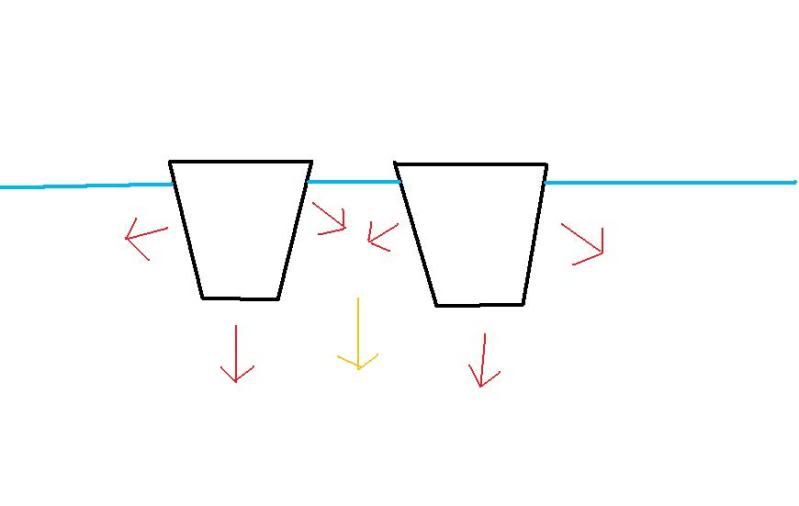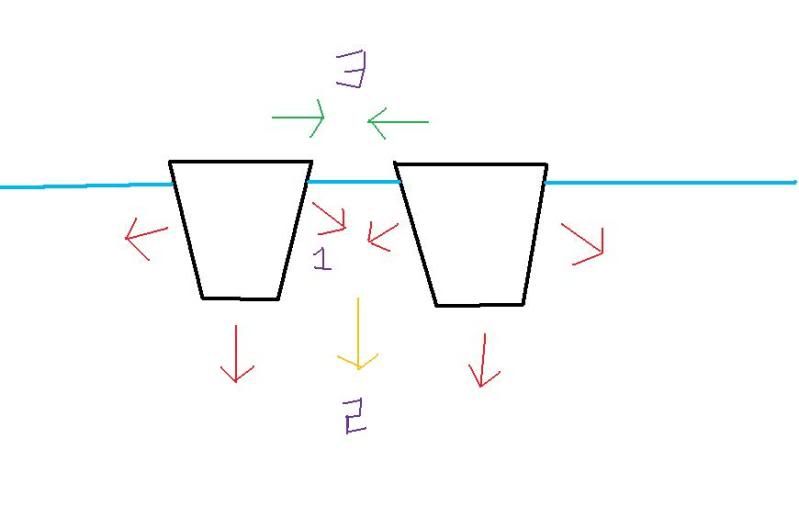
|
|
SUBSIM: The Web's #1 resource for all submarine & naval simulations since 1997
 |
SUBSIM: The Web's #1 resource for all submarine & naval simulations since 1997 |
 10-19-10, 09:17 PM
10-19-10, 09:17 PM
|
#1 |
|
Wayfaring Stranger
|
A buddy of mine claims that two ships located in sight of each other on a becalmed sea will always slowly drift towards each other until they collide.
Is this true or is he telling me a sea story?
__________________
 Flanked by life and the funeral pyre. Putting on a show for you to see. |

|

|
 10-19-10, 09:22 PM
10-19-10, 09:22 PM
|
#2 |
|
Admiral
 Join Date: Jun 2010
Location: Canada
Posts: 2,272
Downloads: 58
Uploads: 0
|
nope, because on a real sea and on a real ship
there are too many things influencing movement 
|

|

|
 10-19-10, 09:41 PM
10-19-10, 09:41 PM
|
#3 | |
|
Navy Seal
 |
No, the ships would need to be massive...
Quote:
|
|

|

|
 10-19-10, 09:51 PM
10-19-10, 09:51 PM
|
#4 |
|
Navy Seal
 Join Date: Mar 2007
Location: New Mexico, USA
Posts: 9,023
Downloads: 8
Uploads: 2
|
In a fantasy perfect fluid (not a real body of water, that's for certain) in a thought experiment I'd wonder about surface tension when they were very close. Other than that, yeah, the gravitational attraction is so tiny that all the real life complications would make it noise (even becalmed waters have currents, fish, etc—the latter bumping into the boat would have more impact than gravitational attraction.).
Now if we were talking about spacecraft... |

|

|
 10-19-10, 09:52 PM
10-19-10, 09:52 PM
|
#5 |
|
Wayfaring Stranger
|
Tlam that refers to moving ships. This was about becalmed sailing ships. He says you can observe this phenomenon with two wooden matches in a bowl of water.
__________________
 Flanked by life and the funeral pyre. Putting on a show for you to see. |

|

|
 10-19-10, 11:39 PM
10-19-10, 11:39 PM
|
#6 |
|
Silent Hunter
 Join Date: Nov 2006
Location: Jakarta
Posts: 4,794
Downloads: 89
Uploads: 6
|
Perhaps this will help.
 Or this  won't happen if they are not close enough from the start..maybe
__________________
|

|

|
 10-20-10, 01:56 AM
10-20-10, 01:56 AM
|
#7 | |
|
Ocean Warrior
 Best of SUBSIM Chairman Join Date: Dec 2008
Location: Milwaukee, WI
Posts: 3,207
Downloads: 59
Uploads: 0
|
Quote:
Finally, he would have to be implying that all the forces involved by themselves must intersect, and they would be completely impossible in all circumstances, because should all forces intersect at all places they must be completely equal and would therefore cancel one another out. PS: By forces I mean, currents, wind, etc. |
|

|

|
 10-20-10, 03:04 AM
10-20-10, 03:04 AM
|
#8 |
|
Soaring
|
If he means it as an illustration of principal gravitational attraction between two masses, then he is right in a way, but given the specific details of the example he'd choosen, other (environmental, global, astronomical) effects and variables add to the formula so that the virsible effect, I would expect, is so minimal that you can no longer observe it within a reasonable timeframe.
The example of two matches in a glass of water, if taken as a literal experiment indeed, I would see more as a demonstration of surface tension of water and what it can do, also maybe helped by the coriolis force. General law of gravitation: FG = G * ( M1 * M2) / r^2 F = resulting gravitation force G = Gravitation constant M1, M2 = two masses r = distance between the masses' centre The force of gravitation between two masses is directly proportional to the mass of the two objects. The force of gravitation is in an inverse squared relation to the distance between the two objects: you double the distance, but the force looses 75% in effect. Both objects in this example'S setup, are object two two much more dominating gravitational forces that interfere with them: that of Earth itself, and the moon. Summary: while true in principle, I would not expect to see a visible, gravitation-caused effect between two sailing ships that are in sight to each other, but some miles apart on the ocean: at least not within a reasonable timeframe for observation. the likelihood to notice the said effect, would fall rapidly with growing distance between both objects. I couöld imagine that the said effect just becomes evident when both ships (the centre of their masses, that is) are so close to each other that their outer hulls stand in their ways, crankle against each other, and prevent any further movement towards each other.
__________________
If you feel nuts, consult an expert. |

|

|
 10-20-10, 06:28 AM
10-20-10, 06:28 AM
|
#9 |
|
Sonar Guy
 Join Date: Aug 2010
Posts: 387
Downloads: 7
Uploads: 0
|
I'm confused

|

|

|
 10-20-10, 07:24 AM
10-20-10, 07:24 AM
|
#10 |
|
Kaiser Bill's batman
Join Date: May 2010
Location: AN72
Posts: 13,203
Downloads: 76
Uploads: 0
|
What if one, or both, had a hold full of magnets? Which makes me wonder, which country produces the most magnets for export, and how do they ship them successfully?

__________________
|

|

|
 10-20-10, 08:26 AM
10-20-10, 08:26 AM
|
#11 |
|
Navy Seal
 Join Date: Mar 2007
Location: New Mexico, USA
Posts: 9,023
Downloads: 8
Uploads: 2
|
There is a scale issue with matches in water, and what that shows is surface tension issues. In the ocean—even dead calm—the situation is not as idealized as in a cup of water.
Functionally, in the sea, any wind driving one ship directly towards another (in-detectible breeze, say) would push the two together. Any breeze not directly on a line between the two would push BOTH ships maintaining their separation. Move the breeze randomly, and you'll see that the breezes will then tend to push them both in the same direction OR will push them together (perhaps this is where this notion comes from?). Summed up, they will be pushed together since all other breezes have no effect on separation. |

|

|
 10-20-10, 09:47 AM
10-20-10, 09:47 AM
|
#12 |
|
Wayfaring Stranger
|
Here's how the subject came up.
We were watching this BBC miniseries about a voyage to Australia set in the early 1800's. I forget it's name but the guy who starred in Jurassic park was in it. Anyways, there's a scene where their ship is becalmed in the doldrums and just as night is falling they spot another ship off in the distance, also becalmed. It being too far away identify they were forced to prepare for battle in case it was French since, according to the 1st officer "the ships would naturally drift together eventually unless the wind picked up". Now I said that sounded like a load of bovine feces to me but my friend swore it was a real phenomenon. Since he has a navy background and I most certainly do not, I felt out of my element to argue my opinion and figured that i'd ask you guys being the only group of experts in the subject that I knew. So thanks everyone for your replies. Unless this additional information changes anything i think i'm gonna tell him he is full of it next time I see him. 
__________________
 Flanked by life and the funeral pyre. Putting on a show for you to see. |

|

|
 10-20-10, 11:09 AM
10-20-10, 11:09 AM
|
#13 | |
|
Eternal Patrol
 Join Date: Mar 2006
Location: CATALINA IS. SO . CAL USA
Posts: 10,108
Downloads: 511
Uploads: 0
|
Quote:

Last edited by FIREWALL; 10-20-10 at 12:49 PM. |
|

|

|
 10-20-10, 11:24 AM
10-20-10, 11:24 AM
|
#14 |
|
Lucky Jack
 |
It would only be two ships passing in the night. No other influences.

__________________
“You're painfully alive in a drugged and dying culture.” ― Richard Yates, Revolutionary Road |

|

|
 10-20-10, 11:51 AM
10-20-10, 11:51 AM
|
#15 | |
|
Navy Seal
 Join Date: Mar 2007
Location: New Mexico, USA
Posts: 9,023
Downloads: 8
Uploads: 2
|
Quote:
To be clear, imagine the two ships. There are almost imperceptible winds, randomly shifting through the points of the compass. On the off chance wind comes along a direct line between the ships, the wind hits the windward ship, pushing it towards the 2d ship. The air is disrupted by the windward ship, and so pushes the leeward ship less. Again, this requires they be close enough that the leeward ship is in turbulent flow (a wind shadow from the windward vessel). Note that the same could also be true of subtle wave action. Wave hits the "windward" (in this case "waveward" ? I still seriously doubt this in real life conditions, but it's interesting none the less. I suppose as a sailor in that situation more than once there are 3 cases. No relative movement, relative movement apart, and relative movement drawing them together. Of the 3, only the last is memorable, because only the last is a navigation hazard. They forget the other two, and come up with myths about the latter. Last edited by tater; 10-20-10 at 12:03 PM. |
|

|

|
 |
|
|
